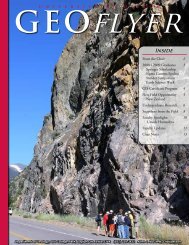Stander Symposium abstract book - University of Dayton
Stander Symposium abstract book - University of Dayton
Stander Symposium abstract book - University of Dayton
You also want an ePaper? Increase the reach of your titles
YUMPU automatically turns print PDFs into web optimized ePapers that Google loves.
POSTER SESSION 1<br />
wealth <strong>of</strong> research regarding the associations between forgiveness and rumination as well as perfectionism and rumination, all three concepts <strong>of</strong><br />
self-forgiveness, rumination, and perfectionism have never been studied in conjunction before. Given past research, I hypothesize that rumination<br />
mediates the relationship between perfectionism and self-forgiveness. More specifically, I predict that increased levels <strong>of</strong> perfectionism will be<br />
associated with increased levels <strong>of</strong> rumination, which, in turn, will result in decreased levels <strong>of</strong> self-forgiveness.<br />
The Relationship between Narcissism, Overconfidence and Risky Behavior<br />
Presenter(s): Arianna T Arnett, Adam Barnas, Megan K Dailey, Jamie L Flannery, Kristen A Kemp,<br />
Peter M Sismour<br />
Advisor(s): Susan T Davis<br />
Psychology - Independent Research<br />
Previous research has shown that overconfidence, the belief that ability to perform a task is greater than actual ability, is associated with risky<br />
behavior (Campbell, Goodie, & Foster, 2004). The present research evaluated the relationship between overconfidence, risky behavior, and narcissism<br />
(confidence and feelings <strong>of</strong> self-sufficiency, <strong>of</strong>ten in the extreme). Male and female undergraduate participants were given a series <strong>of</strong><br />
questionnaires and participated in several tasks to assess overconfidence, narcissism, risky behavior and the need for achievement. Participants<br />
were assigned to either an experimental condition, where participants bet on their ability to answer a series <strong>of</strong> general knowledge questions, or a<br />
control condition, where participants rated their confidence in their ability to answer the same series <strong>of</strong> general knowledge questions. To examine<br />
whether feedback had an effect on confidence, participants either received or did not receive feedback after answering each general knowledge<br />
question. We hypothesized that those who merely rated their confidence would show less signs <strong>of</strong> overconfidence than those who bet on the accuracy<br />
<strong>of</strong> their performance. Results have shown that the participants that were placed in the betting condition were notably more overconfident<br />
than those who were only asked to rate their confidence. We also predicted that narcissism would correlate with risky behavior in participants.<br />
Those who scored higher on a narcissism scale were also more likely to engage in risky behavior.<br />
The Role <strong>of</strong> Visual and Proprioceptive Limb Information in Object Size and Affordance<br />
Judgments<br />
Presenter(s): Adam Barnas, Adam D Sitz<br />
Advisor(s): Benjamin R Kunz<br />
Psychology - Independent Research<br />
In the mirror illusion, visual information from a mirror reflection <strong>of</strong> one hand influences the perceived location <strong>of</strong> the other hand. Holmes, Crozier,<br />
and Spence (2004) demonstrated this visual capture effect on a spatial localization task in which visual information was found to influence<br />
reaching movements towards a target when the seen (in the mirror) and felt (proprioception) position <strong>of</strong> the hand did not match. In this present<br />
experiment, the conflict between vision and proprioception was examined by means <strong>of</strong> a task in which participants adjusted the physical<br />
distance between their two hands to match targets <strong>of</strong> different lengths. In each trial, participants viewed their visible hand and its reflection in<br />
a mirror, while their unseen hand was positioned at one <strong>of</strong> four locations located behind the mirror. At all times, the visible hand was positioned<br />
fourteen cm in front <strong>of</strong> the mirror, and as such, the unseen hand always appeared to be twenty-eight cm from the visible hand regardless <strong>of</strong> its<br />
actual position. While viewing their visible hand and its reflection, participants performed simultaneous finger movements with both hands to<br />
maximize the illusion. Participants then viewed a target block and repositioned their unseen hand such that the distance between their hands<br />
matched the block length. Results suggest that movement <strong>of</strong> the unseen hand relative to the visible hand was biased by visual information from<br />
the mirror, and this bias increased as the visual-proprioceptive conflict increased. These results suggest that the visual information about hand<br />
position overrode the proprioceptive information when the hands were used to indicate perceived object length. Additional experiments will use<br />
affordance judgments to further investigate how visual and proprioceptive information affect judgments <strong>of</strong> limb location and action capabilities.<br />
51

















